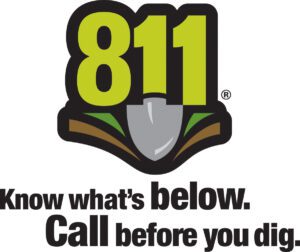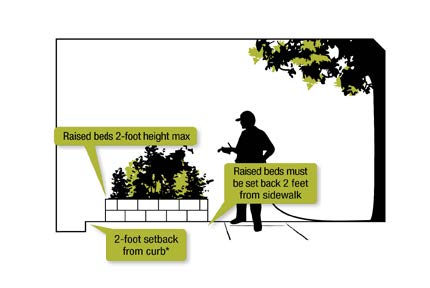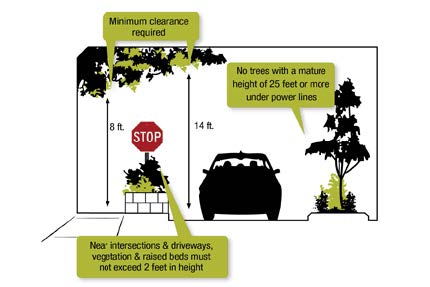Trees in the Right-of-Way
The City of Tacoma requires abutting property owners to maintain adjacent rights-of-way. This includes streets and alleys extending from the owner’s property lines out to the curbs or edges of pavement (includes sidewalks and planting strips) if improved, or if unimproved (unpaved), out to the centerlines. There are several places in the Tacoma Municipal Code where these obligations are stated: Chapters 9.20, 8.30, 8.31, and 12.09.
Abutting Property Owners are Responsible for Maintaining Their Portion of the Right-of-Way in Tacoma.
What is Right-of-Way?
The public right-of-way is typically an easement over the land of the abutting property owner. According to Tacoma Municipal Code (TMC) 8.30.020, public right-of-way includes the area of land, the right to possession of which is secured by the City for right-of-way purposes and includes the traveled portion of: the public streets and alleys, as well as any sidewalks, planting strips, traffic circles, or medians.

Always Call Before You Dig
Always call 811 to locate and identify any underground utilities that may impact the location of your trees before you dig.
Planting, Pruning, & Removal Guidelines
-
Before planting a tree on City ROW, an RTRE planting permit is required. A few tips about tree planting in the right-of-way:
- Planting permits are free and are available through the City’s Permit Website.
- Refer to the City’s Planting and Growing postcards to learn tips and tricks to keep your trees healthy through appropriate tree placement, tree species selection, planting, and care.
- Preapproved Street Trees Lists are a great way to start planning for planting. Be sure to consider how much space you have available to match the size of the mature tree species you choose.
- If you would like to plant a tree that is not on this preapproved list, be sure to do some research on the growth and resource needs. When obtaining your ROW tree planting permit, you will need to provide the growth information including the mature size (height and width) as well as the species.
- Avoid planting trees that are on the Not Recommended and Prohibited Tree List. (Fruit and nut trees are no longer prohibited in the right-of-way).
Tree Placement Standards for Right-of-Way
Minimum Tree Placement Setback Checklist Distance (in feet) Center Line of Tree to Center Line of: Street Corner 25 Stop and Yield Signs 25 Utility Poles 15 Center Line of Tree to Edge of: Driveways 5 Face of Curb 2.5 Pavement 2 Edge of Tree to Edge of: Utility Worker Access Lids 5 Gas Shutoff Valves 5 Fire Hydrant and Hydrant Branches 10 Water Meter, Water Services and Water Mains 5 Storm Inlets, Catch Basins and Manholes 5 Storm/Sanitary Service Connections and Mains 5 Size of Tree When Planted
It is recommended that residential street trees be a minimum of one to one-and-a-half inches caliper(equivalent to about a 15 to 25 gallon container). This is to help protect those trees from damage while the trees get established. Non-residential sites, or sites prone to vandalism (such as near schools or bars), should be a minimum of two to two-and-a-half inches caliper at the time of planting.
Other Planting in the Rights-of-Way: Raised Beds
The City of Tacoma does allow raised beds to be constructed in the rights-of-way. More information regarding raised beds and activities in the rights-of-way can be found
 here.
here.Raised beds need to meet the following standards:
- Maximum height for the built raised bed is two feet
- All raised beds shall be setback from the curb and sidewalk a minimum of two feet
- All raised beds shall provide pedestrian access to the sidewalk with a minimum of three feet width between sections

-
Clearance Standards
Detailed information on regulations and requirements for the right-of-way can be found in the Urban Forest Manual (UFM), or Tacoma Municipal Code Title 9 Public Ways.
 As trees grow, they will need pruning to provide a vertical clearance of at least eight feet over the sidewalks and 14 feet over streets and alleys. Please note that street signage must be clearly visible. Street signage includes regulatory, warning, transit, and other City installed signs.
As trees grow, they will need pruning to provide a vertical clearance of at least eight feet over the sidewalks and 14 feet over streets and alleys. Please note that street signage must be clearly visible. Street signage includes regulatory, warning, transit, and other City installed signs.When planting vegetation in the ROW, be careful not to obstruct signs or sight distance at corners, in order to clearly view pedestrians and traffic. This can usually be accomplished by ensuring trees are planted the proper distance (25 feet) from the street corner and meet vertical clearance requirements (removal of lower branches).
A permit is required prior to performing any street tree pruning work. The permit is available online at no cost from the Permit Center. You may also call or email. Only an owner of the property abutting the street tree, or the owner’s designee, may apply for a street tree pruning permit. Pruning must be done in accordance with best management practices and adhere to industry standards such as American National Standards Institute (ANSI) A300.
Phone: (253) 591-5030Email: permitplandesk@tacoma.gov -
Removal of trees within the right-of-way requires a RTRE permit. All tree removal work shall be in compliance with ANSI A300 and Z133.1 and comply with Tacoma Municipal Code chapters 9.20 Urban Forestry and 13.06.090.B, as well as the standards in the Urban Forestry Manual (UFM).
A permit may be granted if the adjacent property owner, or the owner’s authorized agent, can sufficiently demonstrate that the tree(s) represent one of the following categories approved for removal candidacy:
- Hazardous Tree; defined as: a tree(s) that is found to be likely to fail and has an extreme or high risk to cause property damage, personal injury or fatality in the event of a failure; designated as such by an International Society of Arboriculture (ISA) Certified Arborist, who has obtained an ISA Tree Risk Assessor Course and Exam certification or Tree Risk Assessment Qualification.
- If a street tree is an imminent hazard, call (253)-337-9133, to request an emergency inspection.
- Hazardous Tree Assistance Program
- Conflict Tree; a tree that by its presence in the public right-of-way directly conflicts or interferes with (a) construction or installation of a utility or public right-of-way improvement; (b) activities performed in the public right-of-way to repair or maintain a utility or public right-of-way improvement; (c) development of real property nearest to and directly abutting that portion of the public right-of-way upon which the street tree is located; or that, (d) damages existing improvements within the right-of-way or abutting property. A tree conflicts or interferes when it is demonstrated that there are no reasonable alternatives available to removal of the conflict tree.
- Conflict Tree Removals are subject to a Canopy Loss Fee of $130/caliper inch of tree removed minus an equal caliper inch credit for replacement trees planted.
- Example: One 10-inch caliper tree is removed, three 2-inch caliper trees are replanted.10 inches minus 6 inches (three 2-inch trees) equals 4 inches X $130 = Canopy Loss Fee of $520.
- Conflict Tree Removals are subject to a Canopy Loss Fee of $130/caliper inch of tree removed minus an equal caliper inch credit for replacement trees planted.
- Tree Damaging Sidewalk
- Prohibited Tree; a species of tree that is unlawful to plant in the public right-of-way pursuant to the adopted Prohibited Tree List of the Urban Forest Manual.
- Nuisance Tree; a tree that constitutes a public nuisance pursuant to Chapter 8.30 TMC.
- Fruit Tree
- Significantly Damaged Tree; a tree that has been previously topped or significantly damaged to an extent that, if left unmanaged through extensive pruning and maintenance, could become a future Hazard Tree.
Canopy Loss Fee only applies to Conflict Trees. All other Tree Work in the ROW permit types are no-fee permits.
All stumps and surface roots of trees removed shall be ground or removed to at least 8 inches below the surface of the ground.
The following shall not be considered criteria for removal:
- Obstruction of view
- The cost of routine tree maintenance (pruning, watering, fertilizing, etc.)
- Normal maintenance such as raking of leaves and flowers and cleaning of gutters
- Hazards that can be controlled or eliminated through appropriate pruning or maintenance
- Potential damage to public infrastructure or private property, if damage can be avoided by pruning, root pruning, root barriers or other management strategies
- Hazardous Tree; defined as: a tree(s) that is found to be likely to fail and has an extreme or high risk to cause property damage, personal injury or fatality in the event of a failure; designated as such by an International Society of Arboriculture (ISA) Certified Arborist, who has obtained an ISA Tree Risk Assessor Course and Exam certification or Tree Risk Assessment Qualification.
Preapproved Street Trees Lists are a great way to start planning for planting. Be sure to consider how much space you have available to match the size of the mature tree species you choose.
Detailed information on regulations and requirements for the right-of-way can be found in the Right-of-Way Design Manual, or Tacoma Municipal Code Title 9 Public Ways.